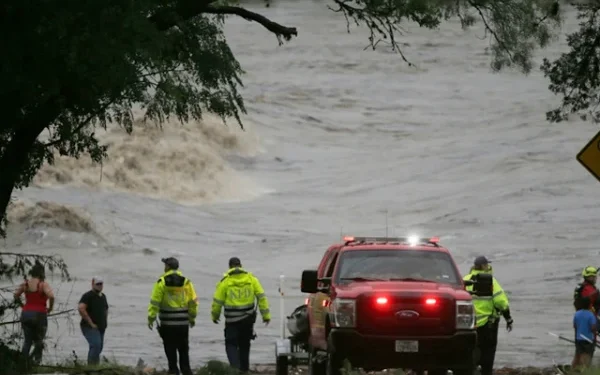TEXAS, US – In response to the unprecedented floods that have wreaked havoc across the state of Texas, President Donald Trump has officially declared Texas a federal disaster zone, authorizing emergency funds and federal assistance to support ongoing relief efforts. The move comes as heavy rains and catastrophic flooding have claimed the lives of at least 80 people, with dozens still missing and entire communities submerged.
The disaster declaration was signed late on Wednesday following a formal request from Texas Governor Greg Abbott, allowing the federal government to swiftly mobilize resources, including rescue teams, supplies, and emergency infrastructure support, to assist local and state agencies overwhelmed by the magnitude of the disaster.
🚨 The Scale of the Texas Flood Disaster
The heavy rainfall began earlier in the week, with nonstop downpours inundating cities, towns, and rural communities across central and eastern Texas. Some regions have reported receiving more than 20 inches of rain in less than 48 hours, breaking century-old weather records. Particularly hard-hit areas include Kerr County, Travis County, and parts of the Texas Hill Country, where swollen rivers and creeks quickly overflowed, swallowing roads, bridges, homes, and vehicles.
Camp Mystic, a well-known riverside retreat near the Guadalupe River, became the focus of intense rescue efforts. Families, vacationers, and camp counselors were caught by surprise as rapidly rising water levels inundated the campgrounds. Authorities reported that multiple helicopters and boats were deployed to evacuate individuals from trees, rooftops, and submerged vehicles.
🧭 Areas Most Affected
Among the most severely impacted locations are:
- Kerr County: Ground zero for flood-related fatalities, with most of the deaths occurring here due to flash floods near the Guadalupe River.
- Austin and San Antonio Metro Regions: Parts of major highways have collapsed, and emergency shelters have been established in local schools and churches.
- Rural Eastern Texas: Small towns have been virtually cut off, with power outages and no access to clean drinking water or communication.
📢 Federal Response: Trump’s Disaster Declaration
By declaring Texas a disaster area, President Trump opened the door for a multifaceted federal response, including:
- Deployment of FEMA (Federal Emergency Management Agency) teams for on-ground support.
- Release of federal funds to help rebuild homes, infrastructure, and public utilities.
- Emergency grants for temporary housing and home repairs for displaced families.
- Small Business Administration (SBA) disaster loans to assist affected businesses and homeowners.
In his statement, President Trump expressed solidarity with Texans, stating:
“Our hearts go out to the families affected by this devastating tragedy. The federal government stands with Texas in this difficult time, and we are mobilizing every resource available to help rescue, rebuild, and recover.”
🧑🚒 Rescue Efforts in Full Swing
Search-and-rescue operations are being led by local authorities, the Texas National Guard, FEMA teams, and volunteer groups. First responders have worked round the clock, using airboats, helicopters, drones, and all-terrain vehicles to locate stranded individuals.
According to Texas Emergency Management, more than 6,000 people have been rescued from floodwaters so far, with thousands more evacuated as a precaution. Temporary shelters have been set up across the state, currently hosting over 25,000 displaced residents.
Local volunteer organizations, such as Team Rubicon, Cajun Navy, and Texas Baptist Men, have joined forces to distribute emergency supplies like clean drinking water, non-perishable food, clothing, and medical kits.
🌧️ Climate and Meteorological Factors
Meteorologists attribute the historic flooding to a “stationary frontal system”, which trapped moisture-laden air over central Texas. The National Weather Service has classified the rainfall as a 1-in-500-year event, underlining the rarity and severity of the storm.
Experts also point to climate change as a contributing factor, noting that warmer Gulf waters are intensifying storms and increasing the frequency of extreme weather events across the southern United States.
🧾 The Human Toll and Community Impact
The floodwaters have left behind a trail of destruction. As of Thursday:
- Over 45,000 homes are damaged or destroyed.
- Thousands of families have lost their livelihoods.
- Critical infrastructure, including roads, bridges, and power lines, has been severely damaged.
Tragically, many of the victims include the elderly and children who were unable to evacuate in time. Emergency services report that many fatalities occurred in low-lying rural communities where flash floods struck overnight.
🏛️ Political and State Coordination
Texas Governor Greg Abbott, in a joint press conference with FEMA Administrator Deanne Criswell, confirmed that state and federal teams are working hand-in-hand to assess damage and coordinate a full-scale recovery.
Abbott noted:
“This is one of the most devastating natural disasters in Texas’ recent history. We thank President Trump for the rapid federal response and for standing with Texas as we begin the long road to recovery.”
He urged residents to remain vigilant, avoid flooded roads, and follow all evacuation orders.
🛠️ Rebuilding and Looking Ahead
In addition to immediate relief efforts, state officials are already planning the long-term recovery process, which could take months — or even years — depending on the extent of the damage. Experts estimate the total economic loss could exceed $10 billion, with significant impacts on agriculture, real estate, energy, and tourism.
The rebuilding process will focus on:
- Restoring infrastructure: Power lines, water treatment plants, bridges, and roads.
- Reconstructing homes and schools: With assistance from federal housing programs.
- Economic recovery: Special grants and loans for businesses affected by the disaster.
- Improving flood preparedness: Investment in levees, drainage systems, and early warning mechanisms.
🤝 Support and Relief Programs
In response to the crisis, numerous relief funds and community organizations have launched donation drives. Among them:
- American Red Cross: Actively supporting shelter, food, and medical care.
- Salvation Army Texas Division: Providing meals and clothing for flood victims.
- Local faith-based charities and GoFundMe campaigns: Helping specific communities.
📰 Media Coverage and Social Media Support
Media outlets from around the globe have focused attention on the crisis, showcasing the resilience of the Texan people, the bravery of rescue workers, and the challenges ahead.
Social media platforms like X (formerly Twitter), Facebook, and Instagram have become tools for real-time information, fundraising, and community mobilization. The hashtags #TexasFlood2025, #PrayForTexas, and #TexasStrong have been trending for days, with thousands expressing solidarity and offering help.
📌 Conclusion: A Nation Responds
President Trump’s disaster declaration is a crucial step in addressing the Texas flood catastrophe, unlocking federal resources to provide much-needed relief and support to the devastated region. As Texas begins to recover, the resilience of its people, combined with coordinated federal and state efforts, will be essential in navigating this monumental challenge.
The floods serve as a powerful reminder of the increasing intensity of natural disasters and the importance of preparedness, swift action, and unity in the face of crisis. The road to recovery will be long, but with national and international support, Texas will rebuild—stronger than ever.

























